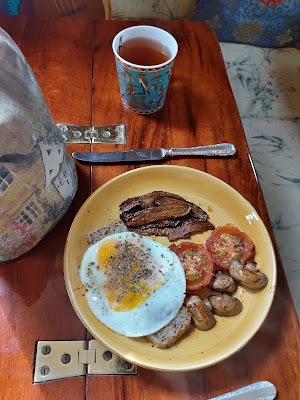Most people eat a cold breakfast. I’m not fond of commercial breakfast cereals: they’re either sweet or tasteless, are bulky and expensive and usually not particularly nutritious. Muesli – preferably home-made – is a much better bet.
Oats are one of the darlings of the Healthy Eaters at the moment: Folic acid, complex carbohydrates, good for blood pressure – the whole nine yards. In addition to oats in your muesli, are all the other goodies, which are delicious and Good For You and ideally include apricots, pumpkin seeds, prunes, Brazil nuts (for selenium) raisins and dates, all of which give you quantities of essential vitamins and minerals as well as tasting wonderful. A quarter cup serving of my muesli, together with milk and/or yoghurt will give you a superbly nutritious breakfast, which is filling and will keep you going until lunch time, without wanting a snack.
The recipe below makes enough muesli to fill a 3 l (3 qt) container – 48 single servings, 24 if you like a hearty breakfast. As it’s a bit of a schlep to make, it’s worth doing in quantity. Before buying dried fruit, ensure that they’re pitted; health food versions often are not. They’re a nuisance to do yourself and a hazard to teeth if left in. I prefer seedless raisins, too.
Incidentally, I find scissors the best for chopping the fruit and nuts. This makes a rich and filling muesli: some people might prefer a higher ratio of grains to fruit and nuts. Vary the latter according to cost and availability.
Ingredients
- Half fill the container with the oats or mixed flakes.
- Add the pumpkin seeds, sunflower seeds and raisins. Mix everything together.
- Halve the nuts, add and mix.
- Chop the dates, add and mix.
- Chop the apricots, add and mix.
- Chop the prunes, add and mix.
- Top up the container with oats/flakes and mix one more time.
- Muesli is very good with hot milk in cold weather.
- Top with slices of fresh fruit – nectarines, raspberries and strawberries are particularly good.
- In colder weather, I like to heat some fruit to put over the muesli. Squeeze a large orange into a small pan, add sliced banana and scoop out the contents of a kiwi fruit or persimmon or anything else you can lay hands on.
- Serve with thick yoghurt. I like a quarter cup of muesli mixed with a good dollop of yoghurt and no milk.
- Use any other nuts or dried fruits that take your fancy. Add desiccated coconut, too.
- Use fruit juice instead of milk.
- You can also put your muesli into a pan with milk or water and cook it like porridge (see recipe).











